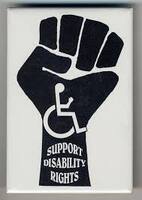
(ID: A sphere that will be on the book cover. It is white and titled on its axis like the globe with words printed in various directions covering it. The word "Disability" is in ALL-CAPS and blue font and features prominently across the center. The rest of the words are in lowercase and either black or grey, and they all relate to disability justice. Among those clearly legible are: solidarity, assistance, independence, support, and autonomy)
Table of Contents
- Introduction by Michael S. Jeffress, Joy M. Cypher, Jim Ferris, and Julie-Ann Scott.
- Language Matters: Disability and the Power of Taboo Words by Joanne Arciuli, and Tom Shakespeare.
- Communicating by Accident: Dysfluency, the Non-Essential, and the Catastrophe by Joshua St. Pierre.
- A Framework for Cross-Neurotype Communication Competence by Emily Stones.
- Microaggressions Toward People with Disabilities by Danielle Sparrow, Erin Sahlstein Parcell, Emily R. Gerlikovski, and Dathan N. Simpson.
- “When We Say That It’s Private, a Lot of People Assume It Just Doesn’t Exist”: Communication, Disability, and Sexuality by Ameera Ali.
- Ableism and Intersectionality: A Rhetorical Perspective by James L. Cherney.
- Performing FitCrip in Daily Life: A Critical Autoethnographic Reflection on Embodied Vulnerability by Julie-Ann Scott-Pollock
- On a Scale of Zero to Ten: A Lyric Autoethnography of Chronic Pain and Illness by Shelby Swafford.
- On Being a Diabetic Black Male: An Autoethnography of Race, Gender, and Invisible Disability by Antonio L. Spikes
- Physical Disability in Romantic Relationships: Exploring How Women with Visible Physical Disabilities Navigate Conversations about Their Identity with Male Romantic Partners by Lisa J. DeWeert and Aimee E. Miller-Ott.
- Disposable Masks, Disposable Lives: Aggrievement Politics and the Weaponization of Disabled Identity by Brian Grewe and Craig R. Weathers.
- Disability Talk with Machines: Reflections on Chatbots, AI & Other Machines Whereby “We” Communicate about Disability by Gerard Goggin, Andrew Prahl, and ZHAUNG Kuansong Victor.
- Thinking Inclusiveness, Diversity and Cultural Equity Based on Game Mechanics and Accessibility Features in Mainstream Video Games by Alexandra Dumont and Maude Bonenfant.
- Posthuman Critical Theory and the Body on Sports Night by Peter J. Gloviczki.
- Never Go Full Potato: Discourses of Cognitivism, Ableism and Sexism in “I Can Count to Potato” Memes by Jeff Preston.
- #DisabilityTikTok by Jordan Foster, and David Pettinicchio.
- Communicating Vulnerability in Disasters: Media Coverage of People with Disabilities in Hurricane Katrina and the Tōhoku Earthquake and Tsunami by Liz Shek-Noble.
- “Kept in a Padded Black Cell in Case He Accidently Said ‘Piccaninny’”: Disability as Humor in Brexit Rhetoric by Emmeline Burdett.
- "Oh, We Are Going to Have a Problem!": Service Dog Access Microaggressions, Hyper-Invisibility, and Advocacy Fatigue by Robert L. Ballard, Sarah J. Ballard, and Lauren E. Chu.
- “The Fuzzy Mouse”: Unresolved Reflections on Podcasting, Public Pedagogy, and Intellectual Disability by Chelsea Temple Jones, Kimberlee Collins, Anne Zbitnew, and Jennifer Chatsick.
- Organizational Communication and Disability: Improvising Sense-Sharing by Amin Makkawy, and Shane T. Moreman.
- Overlooked and Undercounted: Communication and Police Brutality against People with Disabilities by Deion S. Hawkins.
- Critical Disability Studies in Technical Communication: A 20-Year History and the Future of Accessibility by Leah Heilig.
- Communication Infrastructures: Examining How Community Storytelling Facilitates or Constrains Communication Related to Medicaid Waivers for Children by Whittney H. Darnell.
- “Governing Deaf Children and Their Parents through (and into) Language by Tracey Edelist.
- #ImMentallyIllAndIDontKill: A Case Study of Grassroots Health Advocacy Messages on Twitter Following the Dayton and El Paso Shootings by Sarah Smith-Frigerio.


 RSS Feed
RSS Feed
